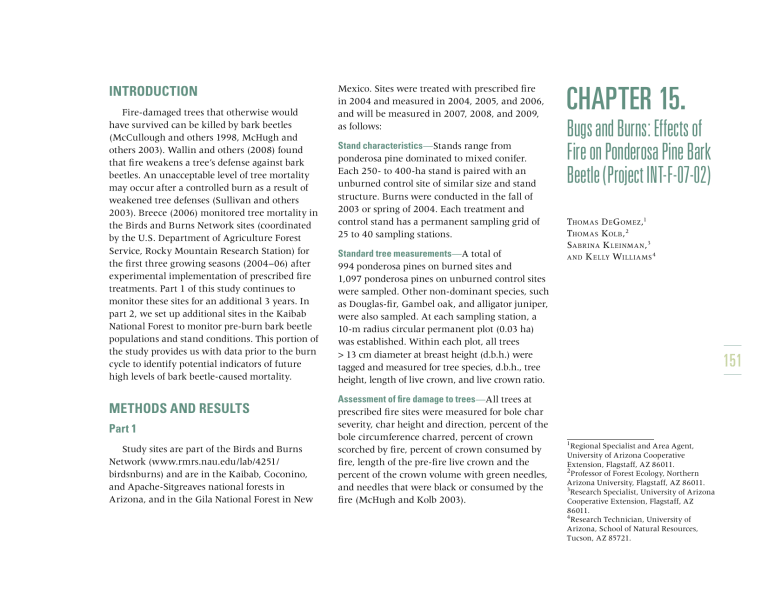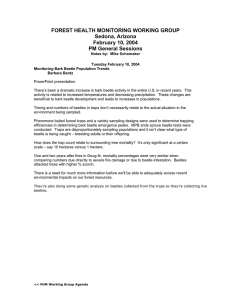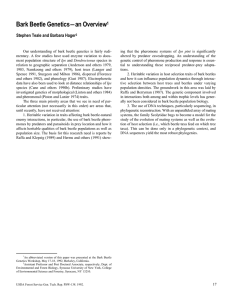cHApTer 15. introduCtion

introduCtion
Fire-damaged trees that otherwise would have survived can be killed by bark beetles
(McCullough and others 1998, McHugh and others 2003). Wallin and others (2008) found that fire weakens a tree’s defense against bark beetles. An unacceptable level of tree mortality may occur after a controlled burn as a result of weakened tree defenses (Sullivan and others
2003). Breece (2006) monitored tree mortality in the Birds and Burns Network sites (coordinated by the U.S. Department of Agriculture Forest
Service, Rocky Mountain Research Station) for the first three growing seasons (2004–06) after experimental implementation of prescribed fire treatments. Part 1 of this study continues to monitor these sites for an additional 3 years. In part 2, we set up additional sites in the Kaibab
National Forest to monitor pre-burn bark beetle populations and stand conditions. This portion of the study provides us with data prior to the burn cycle to identify potential indicators of future high levels of bark beetle-caused mortality.
MethodS and reSuLtS
Part 1
Study sites are part of the Birds and Burns
Network (www.rmrs.nau.edu/lab/4251/ birdsnburns) and are in the Kaibab, Coconino, and Apache-Sitgreaves national forests in
Arizona, and in the Gila National Forest in New
Mexico. Sites were treated with prescribed fire in 2004 and measured in 2004, 2005, and 2006, and will be measured in 2007, 2008, and 2009, as follows:
Stand characteristics — Stands range from ponderosa pine dominated to mixed conifer.
Each 250- to 400-ha stand is paired with an unburned control site of similar size and stand structure. Burns were conducted in the fall of
2003 or spring of 2004. Each treatment and control stand has a permanent sampling grid of
25 to 40 sampling stations.
Standard tree measurements — A total of
994 ponderosa pines on burned sites and
1,097 ponderosa pines on unburned control sites were sampled. Other non-dominant species, such as Douglas-fir, Gambel oak, and alligator juniper, were also sampled. At each sampling station, a
10-m radius circular permanent plot (0.03 ha) was established. Within each plot, all trees
> 13 cm diameter at breast height (d.b.h.) were tagged and measured for tree species, d.b.h., tree height, length of live crown, and live crown ratio. assessment of fire damage to trees — All trees at prescribed fire sites were measured for bole char severity, char height and direction, percent of the bole circumference charred, percent of crown scorched by fire, percent of crown consumed by fire, length of the pre-fire live crown and the percent of the crown volume with green needles, and needles that were black or consumed by the fire (McHugh and Kolb 2003).
cHApTer 15.
Bugs and Burns: Effects of
Fire on ponderosa pine Bark
Beetle (project INT-F-07-02)
t
HoMas
D e
G oMez
, t
HoMas
K olb
, anD
2
1 s abrina
K leinMan
, 3
K elly
W illiaMs
4
1 Regional Specialist and Area Agent,
University of Arizona Cooperative
Extension, Flagstaff, AZ 86011.
2
Professor of Forest Ecology, Northern
Arizona University, Flagstaff, AZ 86011.
3 Research Specialist, University of Arizona
Cooperative Extension, Flagstaff, AZ
86011.
4 Research Technician, University of
Arizona, School of Natural Resources,
Tucson, AZ 85721.
151
152
Bark beetle sampling — Each spring and fall of
2004–06, each sample tree was examined for mortality and bark beetle activity. We assigned each tree an insect attack rating (IAR). If a tree had an IAR of 1 or 2 (partial or mass attack), and
75 percent or more of the crown was fading, a
30 x 30 cm section of the bark was cut out on the north side of the tree at heights of 1 m, 3 m, 5 m, and 7 m. Each bark sample was examined for bark beetles and galleries and, if possible, we identified the species of bark beetle making the galleries.
Statistical analysis — We transformed the mortality data using the arc-sine transformation
(2*arcsin√ Pi ) to account for differences in variance between sites. We performed a repeated measures MANOVA to look at the interaction between time, treatment, and the number of trees killed from bark beetles. We also ran t-tests to determine the significance of tree characteristics and fire damage characteristics on bark beetle mortality rates.
Surveys for bark beetle-related mortality were completed in the summer of 2009. Significantly higher rates of bark beetle mortality were observed in the burned sites (fig. 15.1,
F = 73.3130, df = 1, p = 0.0033), with little to no mortality observed in the unburned control sites.
Starting in 2007, however, mortality from bark beetle attacks dropped off and mortality rates in burned plots became similar to those observed in unburned plots. By 2009, bark beetle mortality in plots for both burned and unburned plots were not significantly different (F = 0.372, df = 1, p = 0.5850). These results suggest that bark beetle-related mortality in burned plots does drop off to background rates a few years following burning. The most common species that remained in these experimental plots were the roundheaded pine beetle ( Dendroctonus adjunctus Blandford), western pine beetle ( D. brevicomis ), and Ips knausi .
When examining tree fire damage, mortality was highly related to higher percentages of crown scorch (t = -8.4024, p < 0.0001), crown consumption (t = -4.3626, p < 0.0001), total crown damage (t = -11.1188, p < 0.0001), and higher bole char ratings ( t = -10.3813, p < 0.0001). These results suggest that trees experiencing higher levels of fire damage may be more susceptible to bark beetle attack following prescribed burning.
Part 2
Four stands were located in the Kaibab and Coconino national forests of Arizona as areas scheduled to be burned along with unburned paired stands. The “standard tree measurements,” as described above, were recorded prior to burning. We compared the tree measurements and fire damage seen at these new stands to the stands used in part 1 to determine any significant differences between stands that may contribute to differences in results using a one-way ANOVA. Two sets of three Lindgren funnel traps were placed within the control and treatment at the four stands. Each trap was baited with a different combination of lures targeting
Ips pini, Ips lecontei , and Dendroctonus brevicomis .
The lures deployed will catch several species of
predators of the targeted bark species. We will analyze trap catches to determine if there was a significant change in ratio of predators to bark beetles before and after burning. Traps were deployed July 9, 2007, to August 20, 2007, prior to burning, and then again during the same time period in 2008, after burning. Trap data was log transformed [log
10
( N + 1)] to correct for heteroscedasticity. We ran a repeated measures
MANOVA to look at interactions between treatments and species caught between 2007 and 2008.
There were no significant differences in tree basal area, live crown, or tree diameter between control and treatment plots in the new study stands. The new study stands differed from those used in Breece (2006) by having lower live crown ratios (F = 160.36, df = 1, p < 0.0001).
Unfortunately, due to budget and time constraints, only two of the stands were burned during the study: Sitgreaves and Tusayan.
Compared to the stands used in the Breece
(2006) study, the new study stands had moderate fire damage with crown damage and bole char.
8.0
7.0
6.0
5.0
4.0
3.0
2.0
1.0
p = 0.0402
0.0
2004 2005 2006 2007 2008
Figure 15.1—The proportion of ponderosa pine trees killed by bark beetles in the experimental plots used in Breece (2006).
The p -value compares trends in bark beetle mortality in burned (diamonds) and unburned stands (open squares).
2009
153
154
However, the difference in fire damage was not significantly different to the fire damage found in the stands used in part 1.
Over the 6-week trapping period prior to burning, relatively few beetles were caught
(see table 15.1, burned = 80 beetles, unburned =
66 beetles). Prescribed burning was performed at Sitgreaves and Tusayan in the fall of 2007.
In 2008, there were significant increases in the number of Ips beetles regardless of treatment, especially for I. pini beetles, while the number of all Dendroctonus species trapped declined.
However, the number of D. valens increased in control and burned stands. The total numbers of beetles caught increased significantly in both burned stands between 2007 and 2008
(F = 8.4022, df = 1, p = 0.0096). However, there were no significant increases in the populations of any specific species including predator to prey ratios (table 15.1) that resulted from prescribed burning (F = 2.4726, df = 8, p = 0.0528).
Very little mortality from bark beetle attacks was observed at the new study sites following the burning treatments. Seven trees died during the course of the study, with five of those trees dying as a result of bark beetle activity. Those five trees were located in the Sitgreaves burned site.
Upon running a one-way ANOVA, this level of table 15.1—trap catch totals by species at two trapping locations in arizona, for the trapping period from july to august in 2007
(prior to burning) and 2008 (after burning) to determine beetle populations in response to prescribed burning treatments
Sitgreaves
Treatment
Burned
Control
Tusayan
Burned
Control
Year
2007
2008
2007
2008
2007 12
2008 208
14
58
11
12
2007
2008
17
38
0
0
0
0
4
1
1
4
0
0
0
0
1
2
0
0
4
1
4
6
4
0
6
5
1
3
1
1
1
5
7
2
1
0
7
0
0
0
2
0
1
10
4
1
8
15
10
13
1
0
0
0
17 164
4 225
8 16
75 153
7 307 10
4 173 45
26
4
11
9
26
10
0
2
0
0
5
0
0
3
5
0
4
3
20
47
17
26
1
11
1
8
12 188 55 3.42
84 453 88 5.15
14 343 38 9.03
58 222 37 6.00
11 25 0.44
14 225 0.06
31
10
28
43
1.11
0.23
mortality does not suggest a significant increase in bark beetle-related mortality in the burned stands
(fig. 15.2, F = 1, df = 1, p = 0.4226). Unlike bark beetle-attacked trees at the Bugs and Burns sites, trees that were attacked at the newer sites were lower in basal area, d.b.h., and height. However, the low mortality rate makes it hard to definitively say that such tree characteristics are indicators of bark beetle mortality for areas treated with prescribed burning. Similar to the trees in the
Bugs and Burns study, attacked trees had higher crown scorch and bole char. Higher than average precipitation during the summer months, lower bark beetle population sizes prior to burning, and the seasonal timing of burning treatments in the area might also have attributed to the lower levels of bark beetle mortality observed at these sites during the course of the study.
2.5
2.0
1.5
1.0
p = 0.4226
5/414
0.5
0/506
0.0
Unburned Burned
Figure 15.2—The proportion of ponderosa pine trees killed by bark beetles ( Dendroctonus and Ips spp. pooled) in burned and unburned stands in the Coconino National Forest in Arizona over two post-fire growing seasons
(2008–09). Numbers above the bars are the total number of trees killed out of the total number of surveyed trees.
The p -value compares the proportion of bark beetle-killed trees on burned and unburned stands.
155
156
diSCuSSion and reCoMMendationS
The results from both the Bugs and Burns study sites and those located in the Kaibab
National Forest indicate that fire damage could serve as an important indicator of bark beetlerelated mortality in prescribed burn sites. Trees that died from bark beetle attacks in both studies had high levels of crown scorch (87 percent in the Coconino plots and 43.6 percent in the Bugs and Burns plots) and higher bole char ratings
(1.6 for both studies). Although few trees died during the course of the study in the Kaibab
National Forest, those that were killed as a result of bark beetle attacks showed higher levels of fire damage. Despite the sample size constraints of this study, the results support the findings of previous work, which found that fire damage was positively related to bark beetle mortality in fire-impacted stands (Breece and others 2008,
McHugh and Kolb 2003, McHugh and others
2003, Sieg and others 2006).
Bark beetle population size may also be an important indicator of the magnitude of bark beetle attacks after a fire. The low mortality in the Kaibab experimental sites could be due to having smaller beetle populations in the area prior to burning. Previous studies have suggested similar conclusions (Bentz and others 1993,
DeNitto and others 2000, Jenkins and others
2008, Santoro and others 2001). While there was a rise in the number of bark beetles present within the treatment stands following burning, the damage was minimal and not significantly higher than mortality witnessed in unburned stands. However, further studies that investigate bark beetle responses with varying sizes of bark beetle populations are needed.
Future reCoMMendationS
• Long-term monitoring on bark beetle populations for a forest are needed to determine if population abundance is at low or high levels.
• Because only two of the four experimental sites were treated with prescribed burning, it is hard to investigate the connection between the burning treatments and bark beetle mortality within the Kaibab experimental plots. A repeat of the study would be beneficial to continue to explore the connection between bark beetle mortality and fire damage.
• Further studies are needed to investigate the relationship between the size of pre-burn bark beetle populations and resulting mortality after a burn. The methods used in this study can provide a good model for future investigations, but should include more study sites and more variation in bark beetle population abundance and diversity.
Literature Cited
Bentz, B.J.; Amman, G.D.; Logan, J.A. 1993. A critical assessment of risk classification systems for the mountain pine beetle. Forest Ecology and Management. 61: 349-366.
Breece, C.R. 2006. Effects of prescribed fire on bark beetle activity and tree mortality in southwestern ponderosa pine forests. Northern Arizona University, School of
Forestry. 65 p. Masters thesis.
Breece, C.R.; Kolb, T.E.; Dickson, B.G. [and others]. 2008.
Prescribed fire effects on bark beetle activity and tree mortality in southwestern ponderosa pine forests. Forest
Ecology and Management. 255: 119-128.
DeNitto, G.; Cramer, B.; Gibson, K. [and others]. 2000.
Survivability and deterioration of fire-injured trees in the
Northern Rocky Mountains: a review of the literature.
U.S. Department of Agriculture Forest Service, Northern
Region Forest Health Protection Report 2000-13.
Missoula, MT: U.S. Department of Agriculture Forest
Service, State & Private Forestry, Region 1.
[Pages unknown].
Jenkins, M.J.; Hebertson, E.; Page, W.; Jorgensen, C.A.
2008. Bark beetles, fuels, fires and implications for forest management in the Intermountain West. Forest Ecology and Management. 254: 16-34.
McCullough, D.G.; Werner, R.A.; Neumann, D. 1998. Fire and insects in northern and boreal forest ecosystems of
North America. Annual Review of Entomology.
43: 107-127.
McHugh, C.W.; Kolb, T.E. 2003. Ponderosa pine mortality following fire in northern Arizona. International Journal of Wildland Fire. 12: 7-22.
McHugh, C.W.; Kolb, T.E; Wilson, J.L. 2003. Bark beetle attacks on ponderosa pine following fire in northern
Arizona. Population Ecology. 32: 510-522.
Santoro, A.E.; Lombardero, M.J.; Ayres, M.P.; Ruel, J.J.
2001. Interactions between fire and bark beetles in an old growth pine forest. Forest Ecology and Management.
144: 245-254.
Sieg, C.H.; McMillin, J.D.; Fowler, J.F. [and others]. 2006.
Best predictors for postfire mortality of ponderosa pine trees in the Intermountain West. Forest Science.
52: 718-728.
Sullivan, B.T.; Fettig, C.J.; Otrosina, W.J. [and others]. 2003.
Association between severity of prescribed burns and subsequent activity of conifer-infesting beetles in stands of longleaf pine. Forest Ecology and Management.
185: 327-340.
Wallin, K.F.; Kolb, T.E.; Skov, K.R.; Wagner, M. 2008. Forest management treatments, tree resistance, and bark beetle resource utilization in ponderosa pine forests of northern
Arizona. Forest Ecology and Management. 255: 3263-3269.
157



